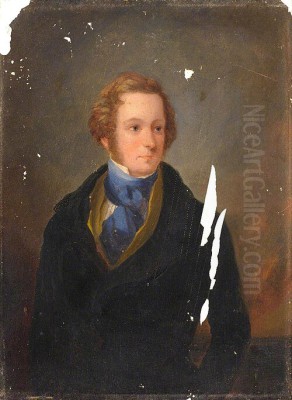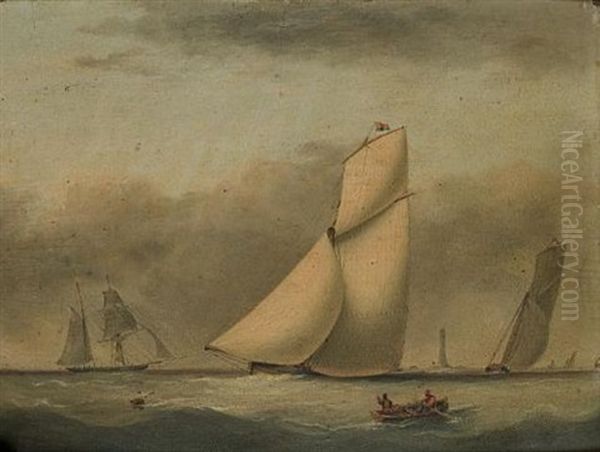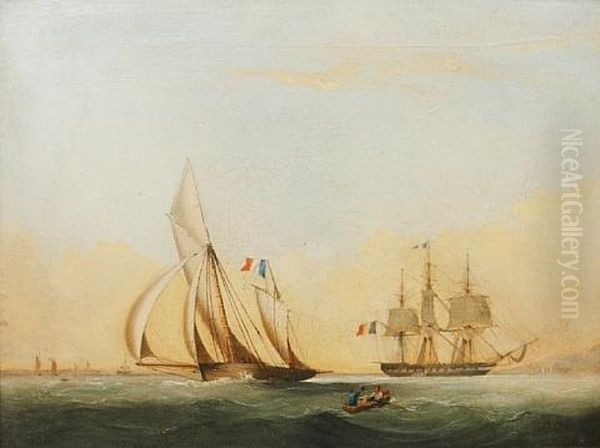
Nicholas Matthew Condy, born in 1816 and passing away prematurely in 1851, was a significant British artist whose career, though brief, left a distinct mark on the tradition of marine painting. Active during the vibrant maritime era of the mid-19th century, Condy specialized in capturing the life of the sea, focusing particularly on ships and coastal scenes. His work is celebrated for its meticulous detail, accuracy, and evocative portrayal of naval vessels, racing yachts, and the bustling atmosphere of Britain's harbours, primarily those around his home base of Plymouth in the South West of England.
Family Ties and Plymouth Roots
Understanding Nicholas Matthew Condy requires acknowledging his artistic lineage. He was the son of Nicholas Condy (1793–1857), often referred to as Nicholas Condy the Elder to avoid confusion. The elder Condy was himself a respected artist, known primarily for his landscape paintings. He had served in the army during the Peninsular War before settling in Plymouth, where he established his artistic career. Nicholas Condy the Elder gained recognition for his depictions of local scenery, including numerous views of the grand Mount Edgcumbe House and its picturesque surroundings.
Nicholas Matthew Condy grew up immersed in this artistic environment. Evidence suggests he lived with his father at Devonshire Terrace in Plymouth, a setting that undoubtedly nurtured his own artistic inclinations. While his father favoured landscapes, the younger Condy developed a passion for maritime subjects, perhaps inspired by the constant activity in Plymouth Sound, a major base for the Royal Navy and a hub for commercial shipping and yachting. This familial connection provided a foundation, but Nicholas Matthew Condy forged his own path, specializing distinctively in marine art. It is crucial to distinguish between the works of father and son, as their subjects sometimes overlapped geographically, though their primary focuses differed. The elder Condy occasionally associated with artists like Samuel Prout, another Plymouth native known for his architectural and topographical watercolours.
A Focus on the Maritime World

Nicholas Matthew Condy dedicated his artistic talents almost exclusively to the sea and the vessels that navigated it. His canvases come alive with the intricate details of warships, the sleek lines of racing cutters, the sturdy forms of fishing boats, and the dramatic beauty of coastal landscapes under various weather conditions. His geographical focus was often the waters around Devon and Cornwall, particularly Plymouth Sound, the River Tamar, and nearby coastal landmarks like Berry Head off Brixham.
His paintings demonstrate a profound understanding of ship construction, rigging, and the way vessels interact with wind and water. This technical accuracy was highly valued in an era when Britain's identity and economy were inextricably linked to its maritime power and prowess. Condy’s work provides a valuable visual record of naval architecture and seafaring practices during a period of significant transition, just before steam power began to dominate the waves, though his focus remained firmly on the age of sail.
Capturing the Thrill of the Race: Yachting Scenes
A notable aspect of Condy's oeuvre is his depiction of yacht racing, a popular pastime among the gentry and naval officers of the period. His paintings of regattas capture the elegance and dynamism of these sailing competitions. One of his well-known works in this genre is The Racing Cutter 'Elizabeth' in the lead at the Royal Western Yacht Club's Regatta, dated 1840. This painting vividly portrays the excitement of the race, with the cutter 'Elizabeth' shown skillfully navigating the waters, sails full, leading the fleet.
Another example is The Reindeer racing off Berry Head, Brixham from 1844. Works like these showcase Condy's ability to convey movement and atmosphere, accurately rendering the specific details of the yachts and the coastal settings. They reflect his close observation of these events, likely facilitated by his residence in Plymouth, a centre for such activities, particularly through the prestigious Royal Western Yacht Club. These paintings were not just artistic representations; they were also documents of specific races and celebrated vessels.
Depicting Naval Power and Historical Events
Beyond the leisure of yachting, Condy frequently turned his attention to the might of the Royal Navy and significant maritime events. His painting The Capture of the Slaver Gabriel, dated 1841, is a powerful example. It depicts the dramatic pursuit and capture of the pirate slave ship 'Gabriel' by HMS Acorn, a brig-sloop of the Royal Navy. The painting captures the tension and action of the chase, showcasing Condy's skill in rendering ships in motion and the drama of naval encounters. This important work is now held in the collection of the Royal Museums Greenwich, a testament to its historical and artistic significance.

Interestingly, The Capture of the Slaver Gabriel is also noted for having inspired a later work on a similar theme by the renowned 20th-century marine painter Montague Dawson. This connection highlights the enduring impact of Condy's compositions. Condy also looked further back into naval history, as seen in his depiction of HMS Surinam struck by lightning, portraying an event that occurred in 1806. This demonstrates his interest in chronicling dramatic moments from Britain's naval past. Another work, A French lugger bearing away from a French frigate, illustrates interactions between vessels of different nations, a common sight in the busy waters off the English coast.
Genre Scenes and Landscapes
While predominantly a marine painter, Condy occasionally explored other subjects, including genre scenes with a maritime flavour and pure landscapes. His work Old Fisherman Taking His Ease offers a glimpse into the life of coastal communities. Originally titled Old Man Smoking, the painting portrays an elderly fisherman relaxing, possibly indoors or in a sheltered spot near the shore. The details are telling: the fisherman wears sturdy, canvas-reinforced work clothes, suggesting a life of hard labour at sea. The background includes elements like naval prints and a depiction of a Portuguese vessel, subtly reinforcing the maritime theme.
Some interpretations suggest the figure's attire or bearing might hint at a military past, possibly reflecting Condy's own speculated, though unconfirmed, experience as a soldier. This painting showcases Condy's ability to capture character and atmosphere in a more intimate setting. He also painted landscapes, such as Mount Edgcumbe House, depicting the famous stately home overlooking Plymouth Sound. While his father was particularly known for painting this location, this specific work is attributed to Nicholas Matthew, showing his capability in landscape depiction, rendered with his characteristic soft colours and attention to detail.
Artistic Style: Detail, Light, and Atmosphere
Nicholas Matthew Condy's style is characterized by its realism and meticulous attention to detail. He rendered the complex rigging of sailing ships, the texture of sails, the play of light on water, and the specific uniforms of sailors with remarkable precision. This commitment to accuracy aligns with the broader trend towards naturalism prevalent in much of 19th-century British art. His primary medium was oil paint, which allowed for rich colours and fine detail, although he also worked in watercolour.
Despite the precision, his paintings often possess a calm, almost classical atmosphere, particularly in his depictions of ships at anchor or cruising in gentle seas. His colour palette tends towards softer, harmonious tones, contributing to this serene quality. While distinct in his focus, his work can be seen in the context of other great British marine painters. He shared a commitment to accuracy with contemporaries like Clarkson Stanfield and E.W. Cooke, though perhaps without Stanfield's dramatic flair or Cooke's scientific precision in rendering geology alongside marine elements. His work contrasts with the turbulent, atmospheric Romanticism of J.M.W. Turner, who explored the power and fury of the sea in a vastly different manner. Condy's niche was the clear, detailed representation of maritime life. Other notable marine specialists of the era include William John Huggins, George Chambers Sr., John Wilson Carmichael, and Samuel Walters, each contributing to the rich tapestry of British sea painting.
Questions of Repetition and Originality
While highly skilled, Condy's working practices have occasionally raised minor questions. Some observers have noted a tendency to repeat certain motifs, figures, or background elements across different paintings. An example cited is a work titled Interior of an Irish Cottage at Balliboyaboyle, Antrim. Research suggests this title might be erroneous, and the scene depicted is likely a cottage interior near Plymouth, possibly one Condy used repeatedly as a setting or compositional element, perhaps mislabelled later.
Such repetition was not uncommon in artistic workshops of the period, where popular compositions might be reproduced with variations. However, it does invite discussion about the balance between original observation and studio conventions in his work. These instances do not significantly detract from his overall achievement but add a layer of complexity when analysing his output. They highlight the practicalities of artistic production in the 19th century.
Collaborations in Print
Like many artists of his time, Nicholas Matthew Condy saw his work disseminated to a wider audience through prints. Several of his paintings were engraved and published, often in collaboration with skilled printmakers. Records indicate collaborations with artists such as Thomas Goldsworth Dutton, a prolific lithographer specializing in marine subjects, as well as William Foster and Edmund Fry. These prints helped to popularize Condy's images of naval ships, yacht races, and coastal views, extending his reach beyond the original canvases. This practice places him within the broader network of artists and publishers who catered to the public's strong interest in maritime themes. The wider artistic landscape also included prominent figures like David Roberts, known for his topographical and architectural views, illustrating the diverse artistic production of the era.
Legacy and Conclusion
Nicholas Matthew Condy's life was tragically short; he died in 1851 at the age of just 34 or 35. Despite his brief career, he produced a substantial body of work that captures a specific moment in British maritime history with clarity and skill. As the son of an established artist, he benefited from a supportive environment but carved out his own specialization in marine painting, becoming a leading practitioner in the Plymouth area.
His legacy rests on his detailed and accurate depictions of ships and the sea, particularly naval vessels and the burgeoning world of yacht racing. Works like The Capture of the Slaver Gabriel and his lively regatta scenes remain important historical documents as well as accomplished works of art. While minor questions about repetition exist, they do not overshadow his talent for careful observation and refined execution. His paintings continue to be sought after at auction, indicating a lasting appreciation for his contribution to British marine art. Nicholas Matthew Condy remains a significant figure, a dedicated chronicler of the ships and shores of mid-19th century Britain.